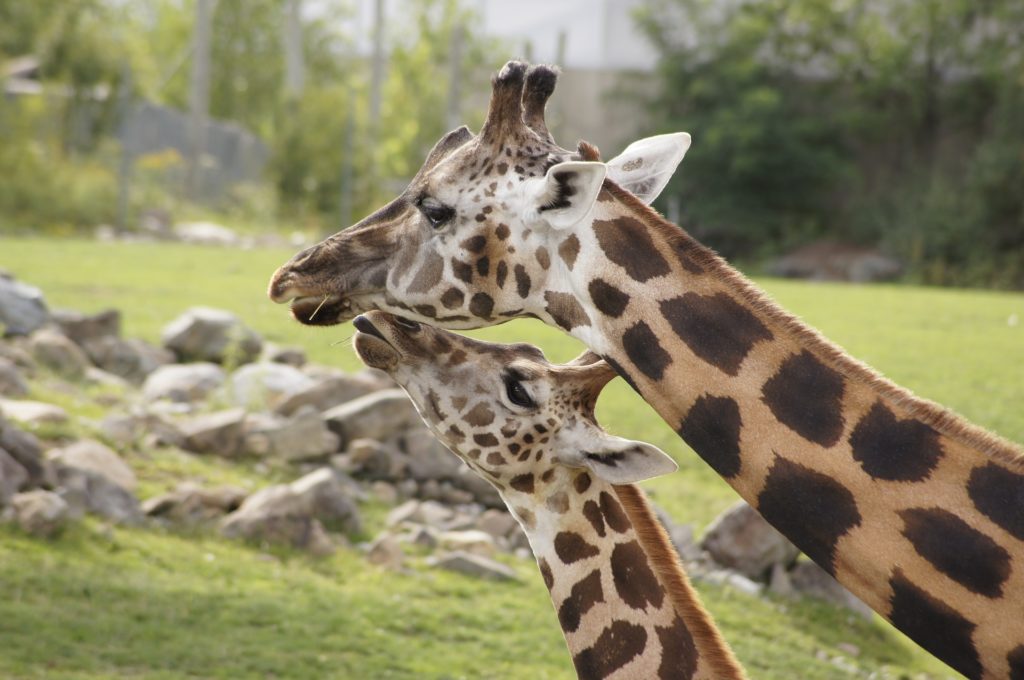Giraffes are the tallest animal ever to walk the earth, hence the simile that goes as tall as a giraffe. The tallness is attributed to its extraordinarily tall neck and its corresponding tall and masculine leg that gives it anchorage it needs. When viewed from a distance, the giraffe is a magnificent and striking beautiful animal, given its posture and demeanor. This article explores 6 interesting facts about the giraffe that we may not be acquainted with.

Interesting facts about the giraffe
1. No two giraffes have the same pattern of spots on their bodies
Yes, comparing two giraffes is like comparing two human fingerprints. For us humans, there is only one-millionth possibility that our fingerprints will match. As a result, fingerprints are an excellent way of uniquely identifying individuals the same way spot patterns on the giraffe explicitly identify one from the other. Astonishingly, even a child giraffe cannot inherit the same spot patterns from their parents. At least we humans inherit our father’s noses and our mother’s hairs. Despite their striking differences in terms of spot patterns, the human eye cannot simultaneously differentiate between these magnificent creatures. You would need to be a biologist and an ecologist to be able to differentiate two giraffes.
2. Giraffes determine their leaders by “necking.”
Giraffes are social animals. They exist in groups of about 15 members led by an adult male. However, in these 15 giraffes, there is an even distribution of male giraffes who may contend for the leadership of the group. Every group deserves a leader, right? We, humans, cast ballots to elect our leader, which is too friendly for the animal jungle. The giraffe community selects its leaders based on strength. The male giraffes, otherwise known as bulls, take part in “necking.” Necking involves the interlocking of necks in bull-fight fashion until one bull concedes defeat. For seemingly meek animals, this way of determining a leader matches seems to complement their humble nature since injuries are very rare in necking.
3. Giraffes give birth while standing
Yes, I know how crazy it sounds, but the long legs of these creatures cannot allow them to squat or adopt a position that makes giving birth much more manageable. Imagine a 1.5-meter thump of a newborn giraffe as a welcome gift to the new world. A new-born baby cannot survive this; it would ultimately die on arrival. Well, a baby giraffe can survive this fall and is only susceptible to predators like lions, cheetahs, and leopards. While it looks like a cruel reality, this is the only logical way for giraffes to give birth. Unlike baby humans, which take about 8 to 12 months to walk, baby giraffes hit the ground 2-3 hours after their delivery. You can imagine the newborn’s enthusiasm to explore the new world.
4. Giraffes take power naps
Imagine the burden of sleeping 20 minutes a day. Well, giraffes are experts at this trade, as they are always on the lookout for predators and also in the search for food. To make matters worse or more intriguing, these power naps by giraffes can only be undertaken while standing. If one giraffe can get in a comfortable position for a nap, he or she can only manage 6 minutes of sleep. How strenuously does it get? Well, that is one of the astounding dispositions about nature. As humans, we are privileged to enjoy about 7 to 8 hours of sleep every day. For the giraffe, it is an obligation. The need to protect oneself and get enough food requires a power nap or 6 minutes of unsettled sleep.
5. They drink very little water
For a creature, almost the height of a classroom, it is assumable that it would drink many gallons of water to compensate for its body mass index. Well, unlike elephants of comparable size, giraffes take very little water. One may wonder, where then do they get their water? It is perceived that giraffes get their water from the plants they eat. Giraffes are foragers; they move in search of food, which they mainly get from trees rather than pastures like other herbivorous animals. I guess the burden of bending the long neck from sunrise to sunset is an excruciating task. Giraffes go for weeks without drinking water. For you, this would mean dehydration and the ultimate loss of strength. We must, therefore, appreciate the wonderful constructs of nature that enable these animals to survive on a little water.
6. Giraffes can live for up to 40 years
Is that interesting considering the wild nature of the jungle punctuated by predators in every short distance? In a normative jungle setting, the giraffe lives an average of 25 years. However, in captivity, they can live up to 40 years because of reduced risks of being killed by predators, diseases, and infections that are characteristics of the jungle. To elongate the lifetime of giraffes, wildlife agencies often taken them into captivity. This path of actions may sound like torture when it is not. There are many giraffe species, some of which face the inevitable threat of extinction by poachers. Taking giraffes into captivity is one way of ensuring their survival so that the balance in the ecosystem can be retained.
Conclusion
As we can see from the facts above, giraffes are wonderful creatures that need constant protection. Their lives are already difficult as it is. While nature takes care of its own, we need to combine our efforts to ensure that these magnificent creatures survive for the decades and centuries to come.


































